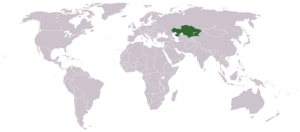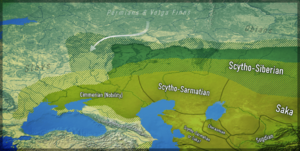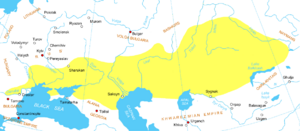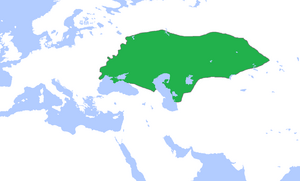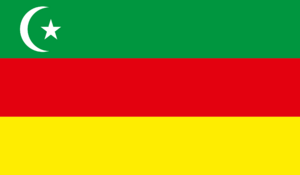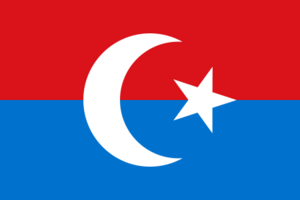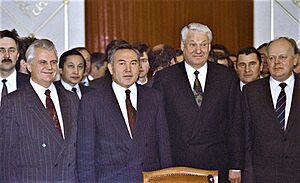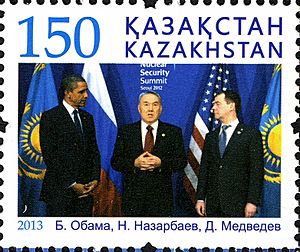History of Kazakhstan facts for kids
Kazakhstan is a huge country in Central Asia. It's the largest country completely within the Eurasian Steppe, a vast grassland. For a long time, it has been a meeting point for different people, states, and empires. People here often lived a nomadic lifestyle, moving from place to place. This way of life greatly shaped the unique Kazakh culture.
Humans first lived in this region about one million years ago. Early human ancestors like Pithecanthropus and Sinanthropus were found in the Karatau Mountains and near the Caspian and Balkhash areas. Later, Neanderthals lived here from 140,000 to 40,000 years ago. Modern humans, Homo sapiens, appeared about 40,000 to 12,000 years ago. After the last ice age, people spread across the country. They hunted animals like the mammoth and woolly rhinoceros, which later died out. These early hunter-gatherers invented bows and boats. They also used trained wolves and traps for hunting.
A big change happened with the Neolithic Revolution. People started raising animals and farming. This led to new cultures like Atbasar and Botai. The Botai culture (around 3600–3100 BC) is famous for being the first to tame horses. During this time, people also started making pottery and polished stone tools. Later, around 2000 BC, they began working with metals. They made copper tools and mined ore in central Kazakhstan.
Contents
Ancient Times and Early Nomads
Humans have lived in Kazakhstan since the Lower Paleolithic period. They mostly lived as nomads, moving with their herds. This lifestyle suited the region's climate and land. Later, during the Bronze Age, cultures like Srubna and Andronovo existed here. From about 500 BC to 500 AD, Kazakhstan was home to the Saka and the Huns. These were early nomadic warrior groups.
Scientists studied ancient horse bones from a burial site in the Kostanay Region. They found that people of the Andronovo culture were riding horses much earlier than thought. These horses were used for riding and pulling carts, not just for food.
Around the first millennium BC, the climate changed. This caused many people to move. After a dry period, new nomadic groups, including the Indo-Iranians (often called the Saka), moved into Kazakhstan.
Turkic People Arrive
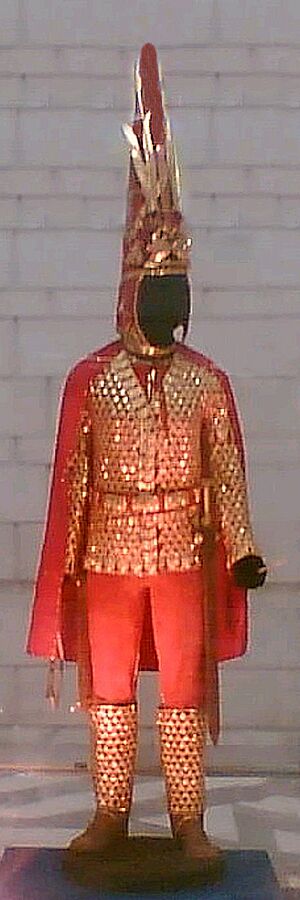
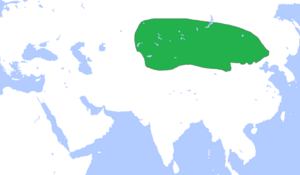
At the start of the first millennium, many different nomadic groups lived in the steppes east of the Caspian Sea. They spoke Indo-European languages and Uralic languages. Over time, Turkic and other languages became common. This happened as new nomadic groups arrived from the east.
When the Huns arrived, many earlier inhabitants moved west into Europe. Others joined the Huns. The Hun Empire then moved its focus westward into Eastern Europe.
Later, from the middle of the 2nd century, the Yueban people formed a state in eastern Kazakhstan. They were connected to the Huns. Over the next few centuries, groups like the Avars and Bulgars traveled through this area.
By the early 6th century, the proto-Mongolian Rouran Khaganate controlled parts of eastern Kazakhstan.
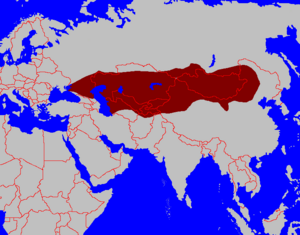
The Göktürks, a Turkic group, then moved west. They pushed the remaining Huns further west and south. By the mid-6th century, they created the First Turkic Khaganate. This large empire later split into Eastern and Western parts. Both were conquered by Tang China. However, the two states reunited briefly as the Second Turkic Khaganate before breaking apart again.
In 766, the Oghuz Yabgu State was formed. Its capital was in Jankent. This state was founded by the Oghuz Turks. They had moved from the Turgesh Kaganate after losing a fight for control.
Cuman-Kipchak Period
In the 8th and 9th centuries, parts of southern Kazakhstan were taken over by Arabs. They brought the religion of Islam to the region. The Oghuz Turks controlled western Kazakhstan from the 9th to the 11th centuries. At the same time, Turkic groups like the Kipchaks and Kimaks controlled the east. Later, the Cumans controlled western Kazakhstan from around the 12th century until the 1220s. Because of this, these vast lands became known as Dasht-i Qipchaq, or the Kipchak Steppe.
During the 9th century, the Qarluq group formed the Qarakhanid state. This state conquered Transoxiana, an area north and east of the Oxus River. From the early 11th century, the Qarakhanids often fought among themselves and with the Seljuk Turks. The Qarakhanids had become Muslim. They were conquered in the 1130s by the Kara-Khitan people. The Kara-Khitan state lasted until the Mongol invasion by Genghis Khan from 1219 to 1221.
Mongol Empire's Rule
When the Mongols advanced into the Kipchak lands, some local leaders fought them. But most joined the Mongols. They even became a big part of the Mongol Empire's army.
After the Mongol Empire was divided in the late 13th century, a western Mongol state called the Golden Horde was formed. It broke away from the main empire. Kazakhstan was controlled by the Golden Horde for over 200 years.
During the rule of Uzbeg Khan (1312–41), Islam became the official religion of the state. It is believed that the Kazakh ethnic group began to form during the 13th to 15th centuries.
Kazakh Khanate (1465–1847)
After the Golden Horde broke up, the Uzbek Khanate was formed in most of modern Kazakhstan. This country, under Abu'l-Khayr Khan, was weak and had a corrupt government. Two sons of Barak Khan, Janibek and Kerei Khan, gathered the Kazakh people. They moved to Jetysu and founded the independent Kazakh Khanate in 1465.
During the rule of Kasym Khan (1511–1523), the Khanate grew a lot. They won many wars against neighboring countries. This made the Khanate famous, even in Western Europe. The first Kazakh set of laws, called Qasym Khannyn Qasqa Zholy (Bright Road of Kasym Khan), was also created in 1520.
Between 1522 and 1538, the Khanate had its first civil war.
In 1643, the Kazakh-Dzungar wars began. These wars were very difficult for the Kazakhs. The Kazakh population was divided into three main groups, called juzes: the senior, middle, and junior. During the rule of Ablai Khan (1771–1781), he united all Kazakhs to fight the Dzungars.
In the 19th century, the Russian Empire became interested in expanding into Central Asia. To reach Afghanistan, Russia began to invade Kazakh lands. To fight back, the last Khan, Kenesary Khan, led rebellions from 1837. These uprisings ended in 1847 when Kenesary was executed.
Kazakhstan Under Russian Rule (1731–1917)
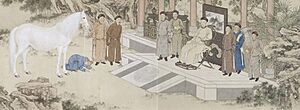
Russian traders and soldiers first appeared in northwestern Kazakhstan in the 17th century. They built forts that later became cities like Oral and Atyrau. The Russians were able to take Kazakh land because the Kazakhs were busy fighting the Zunghar Oirats from the east. Caught between the Kalmyks and the Russians, the Kazakhs were pushed westward.
In the early 1700s, there were many conflicts with the Dzungars. In 1730, Abul Khair Khan, a leader of the Lesser Horde, asked Russia for help. He wanted a temporary alliance against the stronger Kalmyks. But the Russians used this to gain control of the Lesser Horde. They conquered the Middle Horde by 1798. The Great Horde stayed independent until the 1820s. Then, the expanding Kokand khanate to the south forced them to accept Russian protection.
The Russian Empire began to take over the Kazakh steppe. Between 1822 and 1848, the three main Kazakh Khans were removed from power. Russians built many forts to control the new lands. Russian settlers were given land, which meant less land for nomadic Kazakh tribes. Many nomads were forced to stop their traditional way of life and settle down. Because of Russian policies, between 5% and 15% of the population in the Kazakh Steppe were immigrants.
Russian colonization of Kazakhstan in the 19th century was slowed by rebellions. These included uprisings led by Isatay Taymanuly (1836–1838) and Eset Kotibaruli (1847–1858). In 1863, the Russian Empire declared its right to annex troublesome border areas. This led to the conquest of the rest of Central Asia. Two new administrative regions were created: Russian Turkestan and the Steppes. Most of modern Kazakhstan was in the Steppes district.
In the 19th century, Kazakhs had a surprisingly high level of numeracy (ability to do math). It was even higher than Russians in the early part of the century. This might be because of good nutrition and learning from Russian settlers.
By the 1890s, the Russian forts and new settlers began to limit the land available for nomadic herds. This greatly disrupted the traditional nomadic lifestyle.
In 1906, the Trans-Aral Railway was finished. This made it easier for Russians to settle in the fertile lands of Zhetysu. Between 1906 and 1912, over half a million Russian farms were set up. These farms took over grazing land and used scarce water. This put a lot of pressure on the traditional Kazakh way of life.
Many Kazakhs were starving and displaced. In July 1916, the tsar ordered conscription into the Russian imperial army for World War I. This led many Kazakhs to join the Basmachi movement and rebel. Russian forces violently put down this resistance. Thousands of Kazakhs were killed, and many fled to China and Mongolia. Many Kazakhs and Russians continued to fight against the Communist takeover until 1920.
Alash and Turkestan Autonomy
In the early 20th century, Russia started building schools in Kazakhstan. This led to the rise of an educated Kazakh elite. Many of them formed a new political party called Alash. The party was named after a legendary founder of the Kazakh people. Their goal was to create an independent, democratic Kazakh state. The party managed to form the Alash Orda government. It lasted until 1920, when the Bolsheviks banned the party. The Alash Orda controlled most of modern Kazakhstan, except for the southern regions.
The Turkestan Orda, also known as the Kokand Autonomy, was a short-lived state in Central Asia. It existed at the start of the Russian Civil War, from November 1917 to February 1918. It was a secular republic led by a president.
Kazakhstan in the Soviet Union (1920–1991)
In 1920, the Kirghiz Autonomous Socialist Soviet Republic was created. In 1925, it was renamed the Kazakh Autonomous Socialist Soviet Republic. This was when the Kazakhs were officially recognized as different from the Kyrgyz by the Soviet government. The Russian Empire had called both groups "Kirghiz" to avoid confusion with "Cossacks."
In 1925, the capital, Orenburg, was moved back to Russia. Kyzylorda became the capital until 1929. Then, Almaty (called Alma-Ata during Soviet times) became the new capital in 1929. In 1936, Kazakhstan officially became a Soviet republic: the Kazakh Soviet Socialist Republic. It was the second-largest republic in the Soviet Union, covering a huge area.
Difficult Times: Famines and Repressions
Kazakhstan suffered from two major famines. The first famine started in 1919 during the Russian Civil War. The number of livestock in Kazakhstan dropped sharply. This left almost a million people starving. Factories also stopped working.
From 1929 to 1934, during Joseph Stalin's efforts to collectivize agriculture, Kazakhstan faced another terrible famine, known as Asharshylyk. Many peasants killed their livestock to protest Soviet policies. During this time, over one million people died, and 80% of the republic's livestock perished. Thousands tried to escape to China, but many starved on the way.
In the 1930s, the Soviet government built Gulags, which were forced labor camps. There were 11 such camps in Kazakhstan. The most famous was ALZhIR, the Akmolinsk Camp for Wives of Traitors to the Motherland. Many women, including wives of important figures, were arrested without proof and sent to these camps. About 8,000 women were imprisoned in ALZhIR.
Many former members of the Alash movement worked on translating textbooks for new schools. Some joined the Communist Party. However, many educated Kazakhs protested Soviet policies, especially collectivization. The Soviet government tried to suppress and imprison these elites. The harsh conditions in the gulags caused them to age quickly.
World War II and Migration
During World War II, many Soviet citizens and industries moved to the Kazakh SSR. This happened as Axis armies threatened western Soviet industrial centers. Groups like Crimean Tatars, Germans, and Muslims from the North Caucasus were deported to Kazakhstan. The government feared they might help the Nazi invaders. Many Poles were also sent to Kazakhstan, and local people shared their food with them.
More non-Kazakhs arrived between 1953 and 1965 during the Virgin Lands Campaign. This program, led by Nikita Khrushchev, turned huge areas of Kazakh grazing land into farms for wheat. More settlement happened in the late 1960s and 1970s. The Soviet government paid people to move industries closer to Central Asia's coal, gas, and oil. By the 1970s, Kazakhs were a minority in their own republic due to this immigration and the earlier famines.
Kazakhstan played a big role in the Soviet economy by providing coal and oil. But the distance between European factories and Kazakh resources was a problem. This left Kazakhstan with a mixed legacy after 1991. It had a large Russian population, a group of Russian experts needed for the economy, and an energy industry limited by poor infrastructure.
Independent Kazakhstan (1991–present)

On December 16, 1986, the Soviet Politburo removed Dinmukhamed Kunaev as the head of the Communist Party of Kazakhstan. His replacement, Gennady Kolbin, was not Kazakh. This led to protests that were violently stopped. Many people were injured or arrested. In September 1989, Nursultan Nazarbayev, a Kazakh, replaced Kolbin.
In June 1990, Moscow declared its authority over Kazakhstan. This forced Kazakhstan to make its own statement of sovereignty. This caused tension between the republic's two largest ethnic groups, who were about equal in number. In August, Kazakh and Russian nationalists protested outside the parliament. The statement of sovereignty was adopted in October.
Nazarbayev's Leadership
Like other Soviet republics, Kazakhstan's parliament named Nazarbayev its chairman. This position was then changed to president of the republic. Nazarbayev wanted to keep the Soviet Union together. He thought the republics were too connected economically to survive alone. However, he also fought to control Kazakhstan's mineral wealth.
This became very important after 1990. It was discovered that Mikhail Gorbachev had made a deal with the American Chevron Corporation to develop Kazakhstan's Tengiz oil field. Gorbachev had not consulted Nazarbayev. At Nazarbayev's insistence, Moscow gave up control of Kazakhstan's mineral resources in June 1991. Gorbachev's power quickly weakened. Nazarbayev continued to support Gorbachev, urging other leaders to sign a treaty to create a "Union of Sovereign States." This was Gorbachev's last attempt to save the Soviet Union.
Because of the August 1991 Soviet coup d'état attempt against Gorbachev, the union treaty was never put into action. Nazarbayev did not immediately condemn the coup. He continued to support Gorbachev and some form of union. He believed independence would be an economic disaster.
At the same time, Nazarbayev started preparing Kazakhstan for more freedom or full independence. He appointed skilled economists and managers. He also sought advice from foreign business experts. After the attempted coup, the Communist Party of Kazakhstan was outlawed. This allowed Nazarbayev to take almost complete control of the republic's economy. He secured his position by winning an election for president in December 1991 without any opponents.
A week after the election, Nazarbayev became the president of an independent state. This happened when the leaders of Russia, Ukraine, and Belarus signed documents ending the Soviet Union. Nazarbayev quickly called a meeting of the leaders of the five Central Asian states. He suggested a Turkic confederation to balance the Slavic states. This move convinced the three Slavic presidents to include Kazakhstan in a new document of dissolution. Kazakhstan's capital gave its name to the Alma-Ata Protocol, which created the Commonwealth of Independent States. On December 16, 1991, five days before this declaration, Kazakhstan became the last republic to declare its independence.
Kazakhstan followed a similar political path to other Central Asian states. After gaining independence, it kept its government structure and most of its leaders from 1990. Nazarbayev, elected president in 1991, remained in power for many years.
He took steps to secure his position. The 1993 constitution made the prime minister and ministers responsible only to the president. A new constitution two years later strengthened this. Opposition parties faced legal limits on their activities. Within this system, Nazarbayev became popular. He limited the economic shock of separating from the Soviet Union. He also kept peace among the country's many different ethnic groups.
In December 1994, Nazarbayev signed the Budapest Memorandum. With Russia, the United Kingdom, and the United States as guarantors, Kazakhstan gave up its nuclear weapons. The last nuclear sites were closed by 1995.
In 1997, Kazakhstan's capital moved from Almaty to Astana.
After Nazarbayev
In March 2019, President Nursultan Nazarbayev resigned after 29 years in office. However, he continued to lead the powerful security council. He also held the title "Leader of the Nation." Kassym-Jomart Tokayev became the new President of Kazakhstan. His first official act was to rename the capital from Astana to Nur-Sultan, honoring his predecessor. In June 2019, President Tokayev won Kazakhstan's presidential election.
In January 2022, President Tokayev took over as head of the Security Council. He removed Nazarbayev from this post. This happened after violent protests started due to fuel prices. President Tokayev later suggested changes to the constitution. These changes aimed to limit his power and remove Nazarbayev's "Leader of the Nation" title. Kazakhs later voted in a 2022 Kazakh constitutional referendum and approved these changes. In September 2022, the capital's name was changed back to Astana from Nur-Sultan.
Relationships with Other Countries
In the mid-1990s, Russia was Kazakhstan's most important partner for economic and security matters. Nazarbayev supported strengthening the Commonwealth of Independent States (CIS). As some issues cooled relations with Russia, Nazarbayev developed relations with China, other Central Asian nations, and Western countries. However, Kazakhstan still relies mainly on Russia. The Baikonur Cosmodrome, a space launch site, is located near Tyuratam.
Kazakhstan also has good relations with the United States. The US was the first country to recognize Kazakhstan's independence. In 1994 and 1995, the US worked with Kazakhstan to remove all nuclear warheads. In 2010, US President Barack Obama met with Nazarbayev. They discussed making their relationship stronger. They also talked about increasing nuclear safety, regional stability, and economic growth.
See also
- Central State Museum of Kazakhstan
- Early medieval states in Kazakhstan
- History of Asia
- History of Central Asia
- History of the Soviet Union
- Indo-Aryan migration theory
- List of Kazakhs
- List of Kazakh khans
- List of leaders of Kazakhstan
- Politics of Kazakhstan
- Turkic migration


